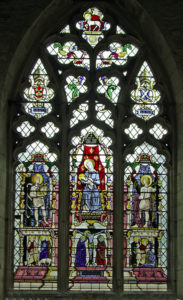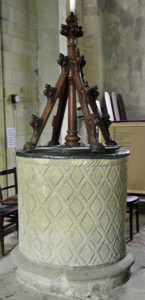We’ve passed the brown sign to ‘Historic Church’ many times as we’ve driven along the A614 past Bainton. It was time we went to investigate it. We knew little about the church. There is little information on the web and there is no guide book in the church, although there are information signs about some of the monuments.
It is a large church in the centre of the village with a tall battlemented west tower and long nave and chancel. The church was completely rebuilt in the mid C14th by the rector, William de Brocklesby. The only part of the original church to survive is the south west corner of the chancel with it’s priest’s door. The tower used to have a spire but this was removed in the C18th. The church was restored in the C19th when the porch was added.
Inside it is a large but rather plain church. Tall octagonal pillars with pointed arches separate nave and side aisles and there is a shallow pointed chancel arch. There are table altars at the ends of the side aisles and in the chancel, with stained glass windows above them. The east window still retains its rather nice original tracery.
On the north wall of the chancel is a carving of St Andrew, patron saint of the parish. The face on the stone corbel beneath him is thought to be that of William de Brocklesby.
At the back of the nave is a Norman tub font dating from 1150 with a diagonal pattern carved round the tub.
Apart from this, the most interesting features are the monuments. On the south wall is an effigy tomb set under a splendid ogee arch. There is some uncertainty over which member of the de Mauley family is buried here. The sign by the tomb says it is Sir Edmund de Mauley who died in 1317. He was a close friend of Henry II and is supposed to have drowned while fleeing after the Battle of Bannockburn. The leaflet in the church says it commemorates Sir John de Mauley, who was rector here and also fought at the Battle of Bannockburn.
Whoever it is, he is dressed in armour. His feet rest on a lion and he is holding a shield. A wyvern is attempting to bite the base of it. The carving in the arch shows the eroded figure of God with two angels carrying a soul in a winding sheet up to Heaven On the wall above are three de Mauley family crests.
The large brass in the floor of the chancel is that of Sir Roger Gudale (or Godeale) who was Rector from 1382-1429. He was much loved and left generous legacies to the church including an organ, clock and money, He also left money for the poor of the parish. He is shown holding a chalice and wearing the robes used for Holy Communion.
On the south wall of the chancel is a monument to Robert Faucon who became Rector in 1629, He was a staunch Royalist and was forced to leave the living during the Commonwealth, but was reinstated during the accession of Charles II.
This is a nice church, but there is nothing particularly special about it. The church is open daily and it is worth a quick look if passing. There is plenty of parking on the road outside. Steps lead up to the lych gate but there is a sign saying disabled access and parking on Applegarth Lane to the north of the church.
There are more pictures “here.”:http://wasleys.org.uk/eleanor/churches/england/yorkshire/east_riding/east_one/bainton/index.html









